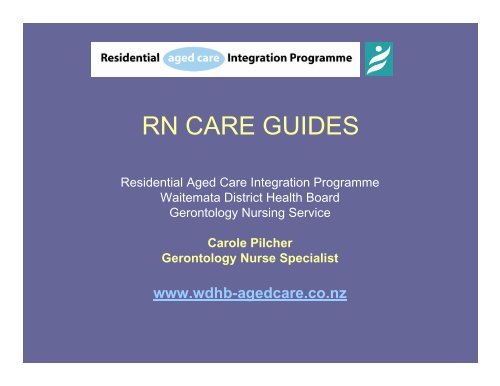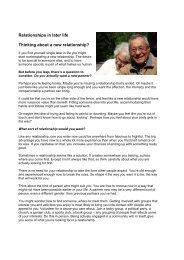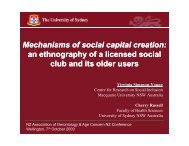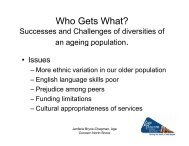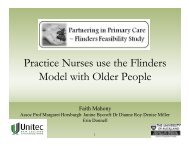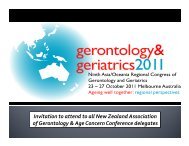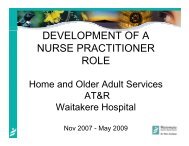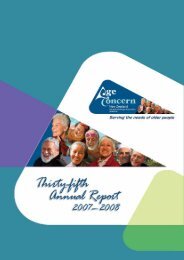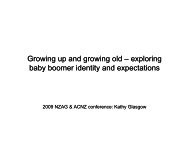6D-4 - Carole Pilcher - CIVIC 1.pdf - Age Concern New Zealand
6D-4 - Carole Pilcher - CIVIC 1.pdf - Age Concern New Zealand
6D-4 - Carole Pilcher - CIVIC 1.pdf - Age Concern New Zealand
- No tags were found...
Create successful ePaper yourself
Turn your PDF publications into a flip-book with our unique Google optimized e-Paper software.
Objectives:Residential <strong>Age</strong>d Care Integration Programme Provide Gerontology Nurse Specialists (GNS) outreach to residentialaged care to increase integration and coordination across services. Collaborate with Residential <strong>Age</strong>d Care providers to develop easy touse RN Care Guides for the common gerontology issues. Provide targeted gerontology education and clinical coaching forresidential aged care nurses and caregivers by advancedgerontology nurses employed by WDHB. Provide targeted specialist wound care intervention and coachingaimed at preventing complications of chronic wounds.
RN Care• Residential <strong>Age</strong>d CareStakeholders Group– <strong>Age</strong>d Care Nurses, NurseManagers– GNS– Health Board <strong>Age</strong>d CareQuality Coordinator• User-friendly guidelines for18 common geriatric careissues– Evidence-based– Expert reviewed• Launch Aug. 2008– 136 RNs from sector attendedGuides
RN CARE GUIDE DEVELOPMENT Registered nurses requested a standardised quickreference tool to assist with assessment and careplanning. The “Geriatric Giants” were e included in the RN careguides because they are those common issues thatput older people at risk.Each RN Care Guide was reviewed four times by theRACIP Work Group . Each RN Care Guide was reviewed by a recognisedexpert in the field (eg MHSOA reviewed the care guideon depression, Hospice reviewed the care guide onpalliative care.).
Objectives in the development of the RNCare GuidesQuick reference for 18 common conditionsencountered when caring for older people inresidential aged care.The Care Guides were developed as a guide only.They are not designed d to replace sound clinicali ljudgement.They were designed to enhance the thoroughness ofthe Registered Nurse’s s assessment.Assist with care planning to achieve the bestoutcome for the older adult.They were intended d to promote early interventiontiand communication with other members of theinterdisciplinary teams and particularly with the olderperson’s s GP
Topics included in the RN Care Guides1. Advanced care planning10. Fracture2. Cardiac11. Incontinence3. Constipation12. Nutrition4. Delirium13. Pain5. Dementia14. Palliative care6. Depression15. Respiratory7. Diabetes16. Skin8. EPOA17. Syncope and collapse9. Falls18. Urinary Tract infections
Chosen Format for the RN GuidesAlgorithm is a sequence of instructions, an explicit,step-by-step procedure for solving a problem.Algorithms may be represented in flow charts.Visio was used to construct the flowcharts in the RNcare guides. Visio is a drawing and diagrammingprogram for Windows from Microsoft that includes avariety of pre-drawn shapes and picture elements thatcan be dragged and dropped onto the Viso palette.This made organising the lay out of the data used inthe guides easier at the same time keeping it tidy anduniform.
Why the chosen format?Not too wordyData organised in a succinct + concise manner Information had to be easy to access –especially in emergency situations.Information had to be easy to follow – step bystep so as to guide the nurse through theprocess.Guides were developed to act as promptp
Implementation of the RN care guidesOnce completed, the care guides were distributed to allfacilities in the Waitemata DHB catchment area(57 facilities).The RN Care Guides are used as the basis forGerontology Nurse Specialist clinical coachingsessions in residential care facilities.Each Gerontology Nurse Specialist has approximately8-10 residential care facilities that they visit regularlywithin their geographical area.
So FarThe gerontology gy nurse specialists have presented thefollowing care guides to their assigned facilities: Respiratory care Cardiac care Urinary tract infections Diabetes GI and constipation Care of the dying Nutrition and hydration
Second edition of RN CareGuidesRecently reviewed again by experts in the field.Second edition now hot off the press.They will be reviewed regularly to maintain currentevidence based nursing practice.The RN care guides are now available on the web siteso every one can access them.www.wdhb-agedcare.co.nz
EvaluationEvaluations were distributed to 57 facilities within the WDHB and 48 facilitiesresponded to this evaluationDo you have any comments about any of the Care Guides listed?(100% positive comments)Some of the comments received were: “An excellent resource – compact and easy to find things” “I believe that this publication is excellent and long overdue”. “ Appreciate all the content of this valuable tool in the working place.Thanks for the great work”.“This is a great tool and quick reference guide for all RNs. Very easy tofollow and appropriate”. “All very clear and easy to follow”. “Very useful and great guidelines to help with planning individual careplans”.
Health Care Assistant Care GuidesWe received such positive feedback regarding gthe RNcare guides the working group representing residentialaged care facilities have formed again to develop the“Health Care Assistant Care Guides”.The working group recognised just how valuable thecare giver input is into this programme and it seniorcare givers were invited to attend meetings to helpdevelop the “caregiver guides”.Care givers in residential facilities are the eyes andears for RN’s.
Health CareAssistant Guides• What the CareAssistants to relay toRNs:– What to observe– What to tell the RN– What to Document– What to Follow up• Care Assistantsbecame part of thestakeholder group• Easily accessible A4yFlip Charts
Health Care Assistant Care GuidesFormat:The caregivers guides have been placed in A3 posterformat and include the following topics.Intake and Output(Fluid/nutritional intake + Bowel and bladder function)Falls, Fractures and IncidentsVital OrgansSkinDementia, delirium and depressionPain
The Health Care Assistants were asked“what they think of the care guides” Is this is a worthwhile project? Should such information be “in your face”? Is this information reassuring for you?Their answers were 100% positive, they aredelighted at having such information available tothem, and the information empowers them actlogically in any related emergency.
CONCLUSION The programme provides a mechanism for proactive carecoordination and clinical coaching with improved healthoutcomes for older people residing in aged care. The response to the programme from residential care facilitieshas been overwhelmingly gypositive. Collaboration has beengreatly increased. We have received many requests and expressions of interestfrom Health Professionals through out <strong>New</strong> <strong>Zealand</strong> regardingthe RN Care guides.. These RN Care Guides and the Care Giver Guides weredeveloped by a team of dedicated Health Professionals (GNS,RN’s, Nurse Managers and Care giver and Clerical Support)from the WDHB and Residential Care facilities. We couldn’tachieve these without this support.


